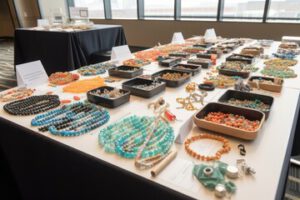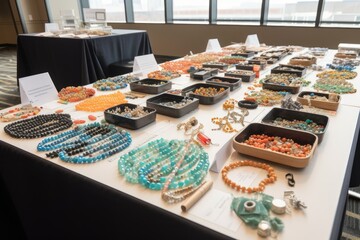Jewelry reveals much about your personal style, from the type of gemstones you choose to the way you pair them. It is also an excellent way to show off wealth and status.
Depending on store size, have at least two people on the floor to greet customers and show them jewelry items. Never leave a customer alone with a tray of valuables. The gemstones in jewelry are not only precious and beautiful, they add an important dimension to the overall design of the piece. They are used as a mark of wealth and power in many cultures, and they have been regarded for centuries as a symbol of love, hope, purity, luck and healing. Some are even believed to have special powers and abilities, which has given them a spiritual significance.
A gemstone is any mineral that is highly prized for its beauty, durability and rarity. While some are found naturally, others are created in laboratories. They are most often cut, faceted or polished to create a finished product that is desirable for jewelry.
Although they are similar in appearance, gems can be distinguished from each other by their chemical composition and atomic structure. They can also be categorized by their color and clarity. For example, a stone’s color can be determined by its impurities. For instance, a beryl containing chromium becomes emerald while one with manganese is pink morganite. Gems can also be categorized by their crystal system and habit, which refers to the shape they form naturally. For example, a diamond has a cubic crystal system while a quartz is monoclinic.
During the Renaissance, gemstones were used to add an extra touch of luxury to fine pieces of art. They are still a significant part of today’s fashion industry, and they are often used to create unique and artistic pieces.
In addition to their beautiful appearance, gemstones are also considered to be quite durable and have a high level of hardness. They are therefore perfect for creating long-lasting, heirloom pieces of jewelry. In fact, some are even considered to be good investments, as they are a safe investment that will retain its value over time.
In addition to being a symbol of wealth, they are also commonly used as gifts for various anniversaries and holidays, such as birthdays or wedding anniversaries. In modern times, gems are also a symbol of good luck and are used as lucky charms by many people. They are also believed to have special healing properties, and some people even incorporate them into their spiritual practices.
Metals
Metals are important jewelry-making elements because they provide strength and durability. They also add a variety of aesthetic qualities to the pieces they’re used in. When choosing a metal for your piece, consider your budget, how it feels in your hand or around your neck, whether you could be allergic to it and how much maintenance it will require over time.
Gold, silver and platinum are all precious metals that occur naturally. These metals are very malleable, which makes them easy to work with and give pieces their luster. They are also durable and have been used as currency and a store of value for centuries.
Other metals are plated or blended with these more expensive metals to create the jewelry you see in stores today. These materials can include bronze, pewter, rhodium and others. These metals are not as strong as the more precious ones, but they can be used to produce a wide range of jewelry styles and colors that wouldn’t be possible with a more expensive metal.
Some of these alternative metals are becoming increasingly popular for use in jewelry-making. Titanium, for example, is 45% lighter than steel and resists tarnishing. It’s a great choice for jewelry pieces that you may wear often or in harsh environments. It’s also hypoallergenic.
Stainless steel is another common material for jewelry. It’s a tough metal that’s less expensive than platinum or gold and has a similar appearance. It’s a great choice for rings, bracelets and necklaces that you will be wearing frequently. It’s also easy to clean and doesn’t react with many chemicals.
Other popular alternatives to these more traditional metals are titanium, cobalt chrome and tungsten. These metals are stronger than stainless steel, but they still look like white gold or platinum. Cobalt is an alloy bonded with copper and nickel. It’s highly scratch-resistant and is a close color match for platinum. Tungsten is a metal that’s very durable and resembles gold in color. It’s a good choice for men’s rings, pendants and other more substantial jewelry items. Like titanium, it’s hypoallergenic.
Design
Jewelry design is an important part of the art of making jewelry. Jewelry designers are artists who use a variety of techniques and motifs to create unique pieces that reflect their individual style and creativity. Jewelry has long been a symbol of cultural heritage and personal identity, and it continues to play an essential role in our lives.
There are many different ways that jewelry can be designed, but there are a few key principles that every piece should follow. These principles include balance, emphasis, movement, proportion and unity. Balance refers to the distribution of size, color, texture and space in a piece of jewelry. There are three types of balance: symmetrical, asymmetrical and radial. Symmetrical balance is when all sides of a piece mirror each other. Asymmetrical balance is when the pieces are different, but they are balanced by size, color and texture. Radial balance is when the elements in a piece radiate from a center point.
In addition to these principles, there are also a few other tools that every jewelry maker should know about. For example, the use of CAD software allows a designer to work in a higher level of visual engineering. This allows the artist to model a piece of jewelry in 3D, which makes it much easier for the customer to see what they’re getting.
Another important tool that every jewelry maker should use is proportion. This refers to the relationship between one part of a design and the rest of the piece. This can be achieved by using a uniform ratio or by simply looking at a piece of jewelry and asking whether it feels proportional to the wearer.
Finally, it’s important for a designer to use the principle of emphasis. This is a way to draw attention to a specific aspect of a design, such as a handmade bead or focal element. This can be achieved by using placement, size and color to highlight a certain area of the piece.
Regardless of how complex or simple a piece of jewellery is, the design is what makes it special. This is what determines how people react to it, whether they love it or hate it, and it’s what makes it something that will be treasured for a lifetime.
Care
Jewellery is more than just an accessory; for many people, it holds great sentimental value. Proper cleaning, handling and storing techniques can help protect and prolong its life. Regular inspection of your jewelry for loose or worn stones, prongs and clasps can also prevent damage or loss.
Different metals have different needs, and it is important to understand the care requirements of each individual piece in your collection. For example, gold is a soft metal that can be easily scratched or bent and is susceptible to tarnishing when exposed to chemicals like chlorine, salt and perfumes. Sterling silver is a durable metal, but it can also be easily scratched or dulled by rough surfaces and some chemicals like bleach and household cleaners. It is therefore essential to clean your jewelry on a regular basis to remove dirt, tarnish and build up.
There are a number of ways to clean your jewellery; however, we recommend using a cleaner specifically made for jewellery (such as Windex) as these are generally safe for most metals and gemstones. Apply the cleaner to a lint free cloth and gently clean your jewellery, making sure to get into all small crevices. You can also use a polishing cloth to restore your jewellery’s shine. Always store jewellery in a clean, dry place and remember to remove your jewellery before applying lotions or cosmetics and before going swimming or working out.
Many people forget to take their jewellery off before applying lotions, hairspray or perfume, and this can cause damage to the gemstones and metals. It is a good idea to adopt the mantra: “put it on after you’re dressed, and remove it before you undress.” It’s also a good idea to remove your jewellery before sleeping to avoid chains breaking or stones falling out. Finally, make a habit of wiping your jewellery with a lint free cloth or jewelry wipes (yes there are actually wipes specifically for jewellery) after each wear and before storing it to eliminate excess oil and residue. This will not only keep your jewellery looking beautiful, but it will also help prevent rust and retard tarnishing.

